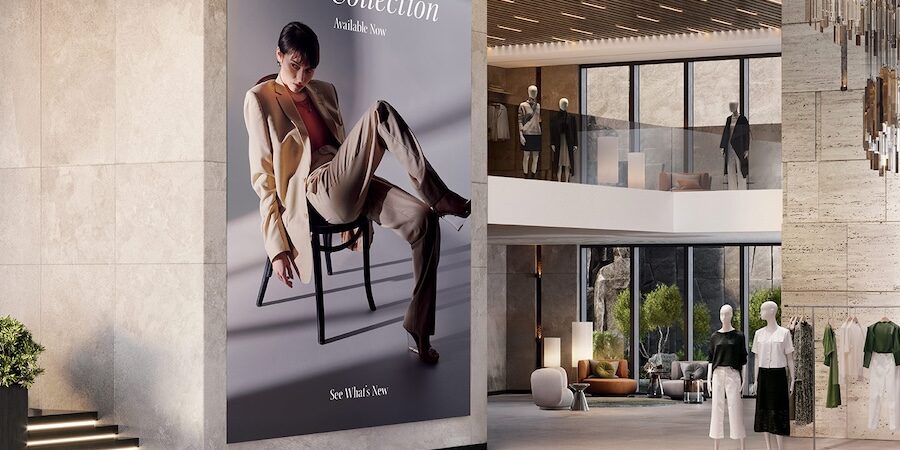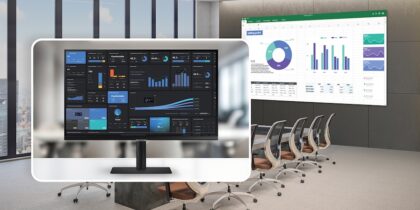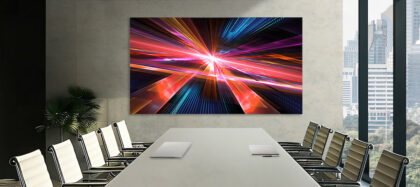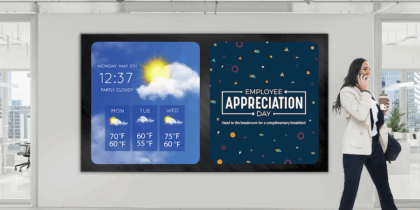No conversation about direct view LED display technology is complete without considering pixel pitch — the density of the light pixels that make up an LED display. That’s why it’s essential to understand what pixel pitch is and how it affects screen appearance — particularly in relation to viewing distance.
Choosing the right pixel pitch for the space is essential to delivering an optimal viewing experience. If the pixel pitch is inappropriate for the viewing distance, the result may not just be subpar but completely counterproductive to your goals.
Here’s what you should know about pixel pitch and LED displays, including how to calculate pitch distance and what solutions foster the best viewing experience.
Pixel pitch: The basics
What is pixel pitch? It’s the distance, in millimeters, between the center of an LED cluster and the center of the next cluster alongside, below and above it. These LED clusters are mounted on circuit boards and backplates to create “modules,” which are then grouped together to form LED cabinets — discrete, consolidated electronic units that can be seamlessly tiled and stacked to form LED video walls.
A significant part of the cost of an LED video wall is derived from the number of clusters per square inch on the display. There’s the cost of the components themselves, as well as the time it takes for expensive robotic manufacturing equipment to pick, place and wire millions of these clusters. This means that the pixel pitch is usually why LED cabinets of the same brand and dimensions can vary significantly in price.
Audience dynamics
The first LED walls were almost exclusively used as stadium replay boards and highway billboards. They were enormous screens that could be easily viewed hundreds of feet away. The problem was that the walls were illegible if you got close to them. That’s because the walls required a pixel pitch to make them legible from 20 millimeters or more. Up close, that same pixel pitch breaks up the image and reveals gaps between the clusters.
Thankfully, advances in LED technology and manufacturing have made much tighter pixel pitches possible, allowing fine-pitch LED displays to perform superbly at close-range viewing in any number of locations. Airports, offices and automotive design centers — to name just a few — are some environments that can benefit from an LED wall with a tight pixel pitch, such as Samsung The Wall IWA and Samsung The Wall MMF.
How to calculate pitch distance
Along with audience dynamics, designers must carefully consider the distance between the screen and the viewer, as it can significantly impact the effect. For example, a direct-view LED wall with a 1.5mm pixel pitch will look outstanding when viewed from a few feet away. If the viewer is, say, 30 feet away, their eyes won’t be able to identify the difference between a 1.5mm pitch and the 3mm equivalent. While a display with a 3mm pixel pitch may look impressive from 25 to 30 feet away, it can appear less sharp up close, as the gaps between individual pixels become visible to the viewer.
How to plan and deploy direct view LED signage
Everything you need to know about choosing your LED displays for optimal viewing indoors and out. Download Now
To calculate the ideal pitch distance, equate 1 millimeter of pixel pitch to 8 feet of viewing distance. If the signs behind the counter of your fast-food restaurant, for example, are 20 feet from your customers, a pixel pitch of 2.5mm is ideal for delivering crisp, convincing visuals. A finer pitch will be no more satisfying from 20 feet away, but will almost certainly cost more. Meanwhile, a bigger pitch will produce cost savings, but only at the expense of image quality and coherence.
Pitch meets resolution
Pixel pitch also has a significant impact on screen resolution. Essentially, the finer the pitch, the more LED modules are deployed in a cabinet, creating a higher display resolution. An LED wall with a 1.5mm pixel pitch has many more pixels per cabinet than a wall with a 4mm pixel pitch, so it uses fewer materials to achieve a high resolution in a smaller space. That means any given resolution can be delivered in a smaller physical space.
Imagine the horizontal width of an LED cabinet is 384 pixels across. It would take 10 cabinets tiled side by side to produce a 4K horizontal resolution of 3840 pixels — so it’s easy to understand that a 4K video wall might actually be the size of a wall in a fairly large room.
MicroLED is the game changer
For top-of-the-line image quality, even when viewed up close, microLED technology changes the game. Here, the size of the LED lights themselves makes all the difference. The microLEDs in Samsung The Wall MMF and MMF-A display the difference from lower-tier models. Because the minute light pixels occupy so little space on the LED module, they can be surrounded by a pure-black background for spectacular contrast levels, creating a richer and more authentic image that demands attention.
This, along with HDR picture quality technology, allows Samsung The Wall MMF and Samsung The Wall All-in-One MMF-A to offer a visual experience comparable to that of high-end domestic televisions, making it ideal for boardrooms, control rooms, home theaters and plenty more.
Premium, attainable LED video walls
Samsung The Wall MMF counts a pixel pitch of 1.56mm or 1.2mm while MMF-A counts a pixel pitch of 1.56mm. With HDR10/10+ picture refinement technology, The Wall M Series optimizes brightness and contrast ratios, illuminating each scene to perfection. This is joined by other features, including AI upscaling and refining, precise color mapping and true black presentation, as well as power efficiency and certified eye comfort.
Smarter selections
Making the smartest selection of a digital display for your business or organization means considering much more than size and placement. In fact, pixel pitch may be the critical factor in determining the best direct-view LED display for any given circumstance. It can be the difference between a display that pops and one that fizzles.
Learn more about the latest Samsung The Wall All-in-One MMF-A — a display designed to deliver unparalleled visual quality wherever you need it.









